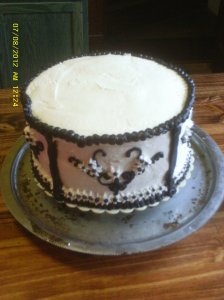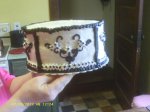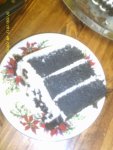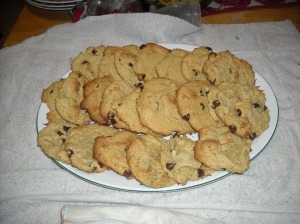Happy Thanksgiving y’all!
The daily management of meals is complicated for families with multiple food allergens. When the holidays arrive, the stresses of meal management multiply to seemingly a thousand-fold. This year our holiday meal issues will include managing for the following foods issues: 2 people who are allergic to milk and bananas, 1 person who can’t eat foods with gluten, 1 person who’s allergic to soybeans and avocados, 1 person allergic to strawberries and 1 person who’s diabetic. This traditional pair of Thanksgiving recipes is written toward persons with these food allergens and with substitution suggestions for the diabetic too.
A Little Schoolhouse On the Prairie Moment (aka An After-schooling Lesson): Allow your children to help you with your holiday baking. The youngest toddlers will have fun with a bowl and wooden spoon, older toddlers and preschoolers can help w/ cookie cutter decorations and stirring. Older kids get an arithmetic lesson in measurements and fractions when they help measure and stir the ingredients together and can practice understanding temperature by setting the oven to preheat at the correct temperature. Ask your teenagers/preteens to convert temps F to C and measurements to metric system for fun or research for the family the origins of various holiday foods to share this information with the family during the meal.
Traditional Pastry Crust
(A Gluten-Free/Soy-Free/Dairy-Free
adaptation of my grandmother’s pastry crust)
*This recipe makes a 2 crust pie or 2 one crust pie plus extra to be used for decoration
1 cup Spectrum Palm Shortening (or lard… grandma always used Crisco, plain or butter-flavored)
*if using lard, chill it in the freezer for an hour or two prior to use.
3 cups Gluten-Free All-Purpose Flour blend w/ xanthan gum already in it (I like Jules Gluten-Free Flour or Namaste Perfect Blend flour) or more as needed
*amount of flour needed will vary due to natural moisture in the flour blend and the type of “shortening” used, lard is softer and will need more flour to make a good crust, however, it’ll also make a little bit larger batch.
1 tsp. salt
1 tsp. cider or rice wine vinegar
Ice water
Place flour, salt and shortening in a large mixing bowl. Cut the flour mixture into the shortening with a fork or pastry blender if doing it by hand. I prefer a more mechanical method for the sake of speed. I place these ingredients in the bowl of my Kitchen Aid stand mixer and cut the shortening into the flour using the whisk attachment.
Add the vinegar and mix well (many of the gluten-free recipes I have come across in the last 2 years for baking have contained a small amount of vinegar with the explanation that it helped somehow activate the xanthan gum that is used as a binder to replace gluten??? Not sure if that’s right or not, as what I know about xanthan gum is that it activates in most liquids, but I liked that the tiny amount of vinegar gave the crust some pleasing flavor, as it was otherwise a little blah to me after using butter flavored Crisco for many years.) Add the ice water very slowly by the teaspoonful, mixing well between additions. You will find this recipe needs less liquid than your typical wheat-flour based pie crust, especially if you use lard in place of shortening.
Once mixed, divide dough into 2 portions. Form into 2 discs and wrap in parchment or wax paper and chill dough for several hours in the fridge.
Remove from the fridge. Line the surface on which you are rolling out your dough with parchment or waxed paper. Sprinkle the paper with tapioca flour or cornstarch. Place your disc of dough in the center of the paper and sprinkle this with tapioca or cornstarch too. Place another piece of parchment or waxed paper on top. Using your rolling pin, roll out dough into a thin sheet. Remove the top layer of paper and gently lay your pie plate on top of the dough upside-down. Carefully and gently flip the plate and dough over together. Press the dough down into the pie plate gently then cut away excess dough with a knife. Crimp or flute the edge of the pie using your favorite method. Shapes may be cut out of excess dough using cookie cutters to place on the pie after it is filled with it’s filling. Try leaves, pumpkins, acorns etc for Thanksgiving or stars, mittens, trees, reindeer etc. for Christmas.
*For a 2 crust pie, repeat the dough rolling instructions for the 2nd crust after filling the pie with it’s filling, then crimp or flute and decorate.
** For a pie shell that is to be filled with a chilled filling, place the crust in the pie plate, prick crust w/fork to prevent air bubbles, then cover with foil and fill the crust with dried beans or pie weights. Bake at 350 F for 20 to 30 minutes (depending on your oven). Cool and fill with chilled filling or wrap tightly in plastic wrap and freeze for later use.
Traditional Pumpkin Pie
Gluten-Free/Casein-Free/Soy-Free
with low-sugar suggestions
Pie Filling:
1 (15 oz) can solid pack/pure pumpkin puree (or if you prefer, roast a pie or heirloom pumpkin in your oven, scoop out flesh and use this in place of canned pumpkin– directions to follow at the end of the post.)
1 cup sugar (or 1 cup Splenda/Sugar blend or 1 cup Stevia in the Raw, if using sugar substitutes, plan to keep this pie chilled in the fridge to prevent it from molding if making it ahead or if you have leftovers)
1 can (15 oz) coconut milk (unsweetened)
3 eggs
2-3 teaspoons ground cinnamon (to taste)
1 tsp.ground allspice
1 tsp. ground ginger
1/2 tsp. ground cloves
1/2 tsp. ground nutmeg or mace
In a large mixing bowl, mix sugar (or substitute) and eggs with a whisk until well blended. Add pumpkin puree and whisk until well blended. Pour in coconut milk and once again mix in very well with a whisk. Stir in spices until thoroughly mixed.
Pour into your prepared pie crust. Decorate top of your pie as desired, sprinkling top of decorative crust pieces with a little granulated sugar or colored sugar sprinkles for sparkle. Bake at 350 F for approx. one hour (or maybe a little longer… you want to bake until the filling appears to have set up since this is a “custard” type pie) depending on your oven. This crust does not brown quite as much as a wheat flour based crust, so personally, I’ve been able to skip the step of covering the edge of my crust with foil and baking at 2 different temperatures.
To Make Your Own Pumpkin Puree:
Choose pie pumpkins or small to medium sized heirloom pumpkins (the green Jaradale and the light orange and dark red-orange “Cinderella” pumpkins are among my favorites for this). Depending on your timing, you can cut the pumpkins in half, scoop out the seeds and place cut side down in a baking pan with a little water in it and bake for 30-60 minutes (depends on size of pumpkins) or until tender when pierced with a fork. Remove from oven and allow to cool.
OR
knock the stem off your pumpkin(s), wrap the whole pumpkin(s) fully in foil and heat your oven to 200 F, place wrapped pumpkin(s) on a cookie sheet(s) and place in the oven before going to bed, allow pumpkin(s) to slowly roast ovennight. Check to see they are tender first thing in the morning and remove from the oven to cool. When cool enough to handle, cut in half and scoop out the seeds.
For both continue as follows…
Scoop out flesh with a large metal spoon and place into a large bowl or the bowl of your food processor (this may need to be done in several batches). Mash puree by hand with a fork or potato masher or puree in a food processor. Set aside the amount needed for your pie or other recipe. Portion the rest out into 1 qt. freezer bags and freeze for later use.
This roasting, mashing and freezing process also works with other types of winter squash and is an excellent way to preserve the squash crop from your garden. (Summer squashes can be grated raw and frozen for later use as well.)






